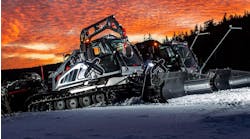What experience has revealed about diesel particulate filters
The cover story in the August 2009 edition of Fleet Maintenance looked back on the first two years of 2007-EPA emission compliant diesel engines for commercial trucks. The EPA had mandated that starting in 2007 all new on-highway diesel engines must limit the emission of particulate matter (PM).
To comply with this regulation, OEMs incorporated diesel particulate filters (DPFs) as part of a comprehensive emissions control system. DPFs trap diesel particulates (soot) in a diesel engine’s exhaust through an extensive filtering process. The PM collected is then oxidized to remove it from the DPF.
At the same time, ultra low sulphur fuel (ULSD) was introduced for use on 2007 or later model year diesel vehicles. A cleaner-burning diesel fuel that contains 97 percent less sulfur than low sulphur diesel, ULSD was developed to allow the use of the improved pollution control devices that reduce diesel emissions more effectively but can be damaged by sulfur.
PRE-BUY
There were record heavy duty truck sales of calendar year 2006 models to avoid the increased cost of the 2007 models due the mandated exhaust aftertreatment systems.
In the summer of 2009, the landscape remained heavily populated with pre-2007 trucks. Low-mileage 2006 models would be the hot commodity in the used truck market for years to come.
In 2009, information was beginning to trickle in about the DPF-equipped trucks. At the time, 2006 and earlier model year trucks dominated use in the trucking industry while 2007 and later models accounted for a much smaller segment.
Now, more than six years later, the rear view mirror can teach us a lot that we didn’t know then. The 2006 truck models have now mostly disappeared from use. Those few remaining in service are tired and spent, having racked up millions of miles. DPF trucks are now the norm.
DOING THEIR JOB
The DPF technology is performing its job well if given proper care. Now, as in 2009, no longer do big rigs belch black smoke with the stench of diesel fuel in their wake. In addition, DPF-equipped trucks run quieter.
“Engineers have worked very hard over a long period of time to reduce emissions while preserving the efficiencies and advantages of the diesel engine,” notes John Wall, vice president and chief technical officer for Cummins (www.cummins.com).
All this has come with a price. In 2007, $5,000 to $10,000 got tacked onto truck sticker prices.
IMPROPER CARE
Many fleets were experiencing problems with their DPFs, due mainly to failing to properly care for them.
“Diesel engines in vehicles have earned a reputation for being dependable, for being powerful, for being energy efficient, and they last forever,” explains Gina McCarthy, assistant administrator, air and radiation, for the U.S. EPA.
But add an EPA-mandated DPF and diesel oxidation catalyst (a device that helps to control diesel emissions) and the only thing you can depend on is unscheduled downtime if you don’t clean the DPF on a regular, proactive schedule. Experience has shown that without proper cleaning the DPF works fine until it cracks, sinters, melts or just plain gets plugged with soot or hardened ash plugs.
OBSERVATIONS
In 2009, many questions remained unanswered. Today we have some answers.
1. The DPF technology and the emissions control systems are working. This technology is effectively filtering diesel exhaust. Diesel exhaust is a complex mixture of gases and PM that contains more toxic air contaminants.
Clear evidence is building that cleaner diesel exhaust helps remove a major health risk as prolonged exposure to diesel exhaust can increase the risk of cardiovascular, cardiopulmonary and respiratory disease and lung cancer.
2. Does a clean DPF improve fuel efficiency? Many fleets are now reporting fuel efficiency gains from 3 percent to as high as 5 percent when DPFs are cleaned regularly.
3. How often does a DPF need cleaning? In general, for heavy duty trucks using low ash oil, the DPF should be cleaned once annually or every 150,000 miles; less for severe-service applications. For medium duty trucks using low ash oil every, cleaning should be every 75,000 miles. These intervals can vary depending on application.
Ash left longer in the DPF begins to set up and harden, making cleaning difficult.
These intervals are based on the real world experience of FSX from many years of cleaning more DPFs.
DPFs should be “inspected and verified suitable for re-use,” advises David McNeill, parts and service manager at Cummins Service Solutions. DPFs that are improperly cleaned or not cleaned at regular intervals are most likely to require replacement.
Filters cleaned at proper intervals “result in improved DPF reliability and durability, as well as reduce the likelihood of frequent regenerations (combustion at high temperatures of the PM within the filter) and associated downtime,” he notes.
4. How can the DPF affect the resale price of a used truck? If a DPF is in poor condition it will need to be replaced and that can add to a used truck’s price tag.
To avoid a disputed appraisal, never sell a used truck that has a plugged DPF and soot blackened stacks (one sign of a failed DPF). Also have on hand cleaning documentation showing proof of annual cleaning with inspection notes showing restriction before and after each cleaning.
Steve Clough of Arrow Truck Sales (www.arrowtruck.com), a seller of used commercial vehicles, feels truck builders did not do a good job of communicating how DPFs should be maintained and that led to problems for customers.
“Our first experience with selling used DPF trucks was not a good one,” he says. “As a result, we do things a lot differently today, including making sure the DPFs are cleaned before the trucks are sold to anyone.”
5. Should the diesel oxidation catalyst (DOC) be cleaned along with the DPF? We recommend five minutes of a Stage 1 pneumatic blowout for the DOC.
6. What is the ROI for a fleet owning a DPF cleaner and how large does a fleet need to be to justify owning a DPF cleaner versus contracting out the cleaning? It’s been our experience at FSX that it is more cost effective to own a DPF cleaner rather than contract with a DPF cleaning service when a fleet has at least 100 DPF-equipped trucks. Such a fleet would pay for the equipment in about one year. The return on investment goes up from there.
7. What happens when DPF cleaning is ignored all altogether? The cells inside the DPF fill with ash. The ash hardens and eventually the DPF plugs, cracks, glazes or melts, destroying the DPF. That, in turn, results in vehicle downtime and added expense. An OEM replacement filter costs around $3,000.
Thus, this makes cleaning or exchanging the DPF the best option for most truck operators. Prices charged for DPF cleaning range between $350 and $500, depending on location and the cleaning method used.
Some manufacturers offer exchange programs in lieu of cleaning, which usually run between $600 and $800 per filter.
8. What DPF cleaning tool should I buy? DPF cleaning systems have been in use for years now and there is a variety to choose from. Do your homework before purchasing one. Key things to keep in mind include:
- Is the DPF cleaner OEM tested or recommended?
- What is the method of cleaning?
- What are the air compressor size and the cubic feet per minute (cfm)/psi rating? (The more powerful the compressor, the more effective and thorough the cleaning.)
- Is the DPF cleaning process visible to the technician? This allows a technician to spot any possible failures, such as cracking.
- Remember, you get what you pay for.
Careful attention needs to be paid to choosing a DPF cleaning service as well.
9 What is the future of the DPF? It is doubtful that DPF technology will become obsolete any time soon as many improvements are being made to diesel emission control systems. Developments include thinner ceramic substrate walls for backpressure reduction; changes in microstructure and porosity of the ceramic media to improve filtration efficiency; increased ash storage capacity with the use of asymmetrical cell technology; and further reduction of nitrogen oxides through the use of NH3 (ammonia) from urea for selective catalytic reduction (SCR) diesel engine emissions control technologies. This technology can now be incorporated as a coating on the DPF itself to perform the same function as the more traditional separate DOC.
But even with technological advances to DPFs, they will only function as designed if they are well maintained.



